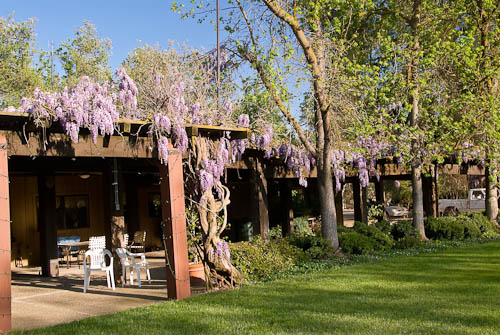Ron Ludekens
Persimmon Harvest
Persimmon Harvest
It's Saturday and it's harvest season - so yes we are working! Since the phones were quiet this Saturday morning, I took a trip over to see the digging of the 3 year Persimmon trees. Why? This is the first year where the 3 year persimmons were coming off the new Drip System. In fact everything in this digging season (and from now on out) is coming off the drip system. I wanted to see how good the roots were developed.
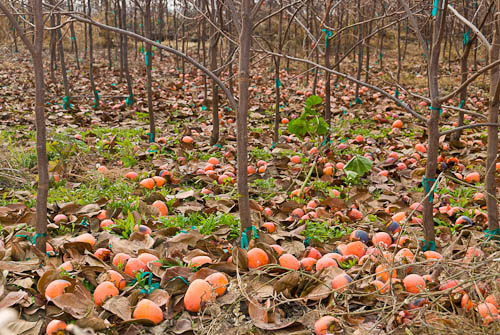
Before looking at the roots, I wanted you to see the crop of persimmon fruit on the ground. Yes, these trees are already bearing fruit! These happen to be Fuyu (Jiro). Actually it creates extra labor cost for us because we needed to send workers in to strip the fruit by hand so as not to break the young limbs of these trees.
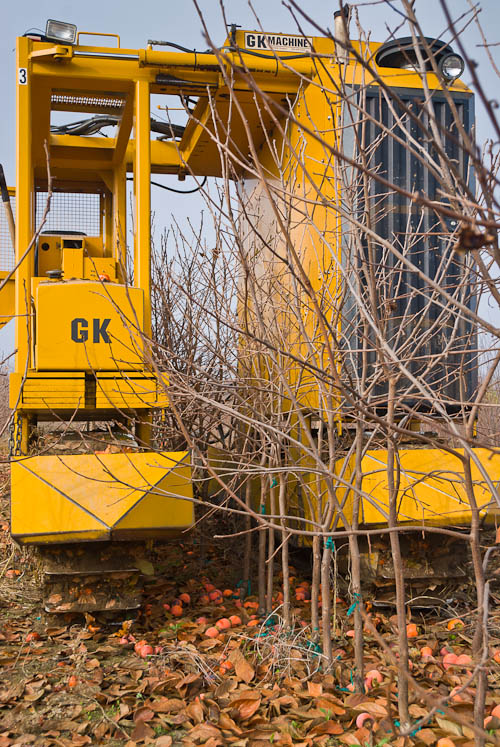
The 3 year field produces the majority of the 3/4" and larger caliper sizes with a few being 5/8" and smaller. A lot of what you see in these photos are 1" to 1 1/4"
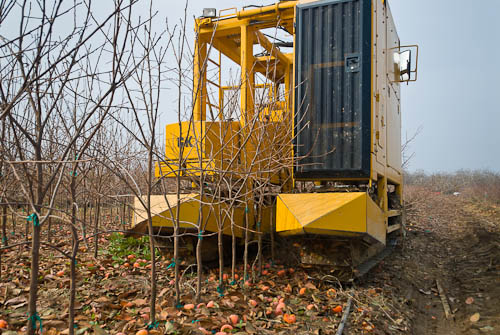
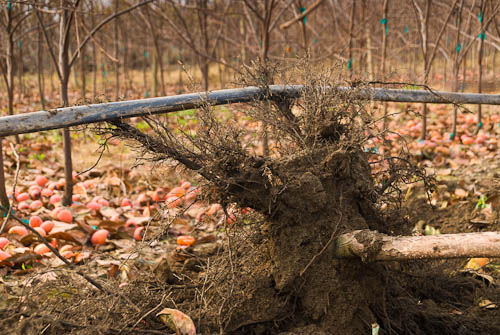
3 Year Persimmon Roots - Drip Tape Dug With Trees
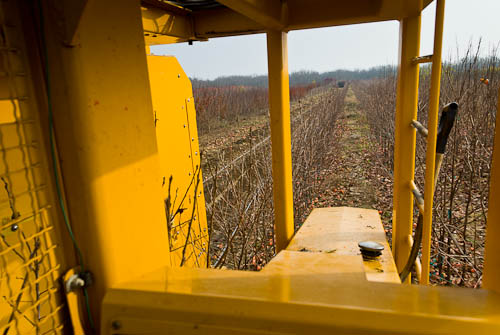
View From Cab of Digger. Driver sits over right side tracks. Trees go between the tracks to blade at rear.
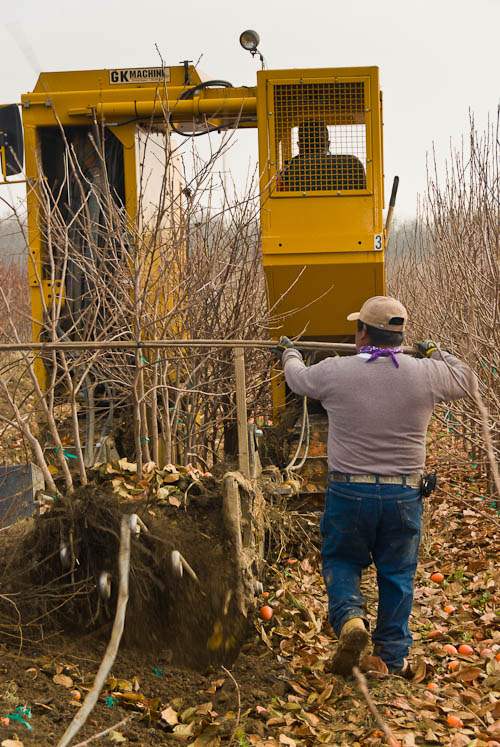
One person follows the digger to make sure the trees all fall to one side. This allows the digger to make a pass down the next row without running over trees that fell the wrong way.
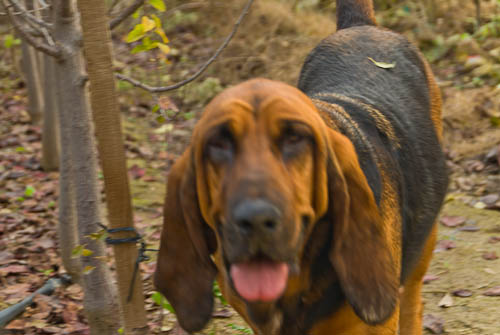
This is the neighbor's overly friendly dog just before he tried to give me a wet kiss and slobbered over my camera lens.
The Persimmon tree crop looks great. There are some sizes that would look really nice in a 24" box for your high end customers.
Ron Ludekens 12-11-2010
Field Shots - Lavender Twist Redbuds
Cercis canadensis 'Covey' - Lavender Twist® Redbud Field Shots
I had a request last week to show what the Lavender Twist Redbuds (Cercis canadensis 'Covey') looked like in the production field. Between rain, fog and being swamped in the office (no the roof is not leaking - just a desk buried in paperwork) I did not get out until this afternoon. Besides I needed a sanity break - or the office needed a break from me.
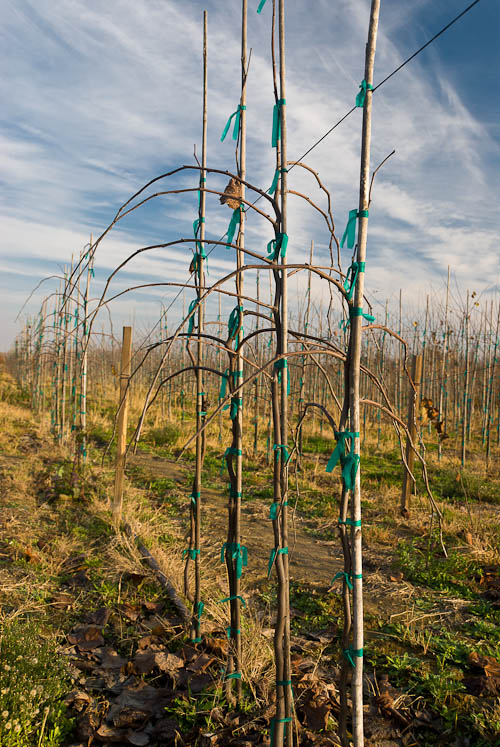
This weeping redbud creates its own production challenges. Without staking, it wants to crawl across the ground. We stake it to bring it upright to about 5 feet before letting it naturally tilt its head back toward the ground. Like most redbuds, it is sparsely branched on its first year top with more its second year. Redbuds tend to throw branches flat sided the first year (if at all) and fill in better the second season of growth.
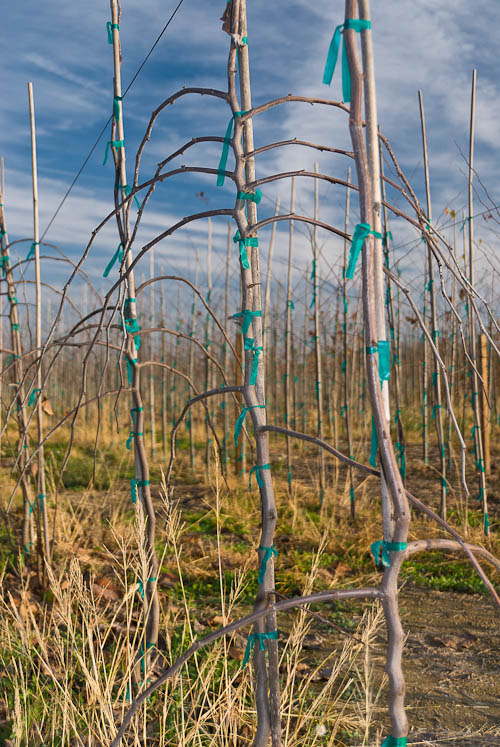
The photos here show Lavender Twist in our three year field (already dormant for harvest). It is a two year top on a three year root. You can see some decent weeping branching on the 5/8", 3/4" and 1" caliper sizes some of it still flat sided which still needs to fill in next season. Then there is new growth from this season above the branching with little or no branching until next year.
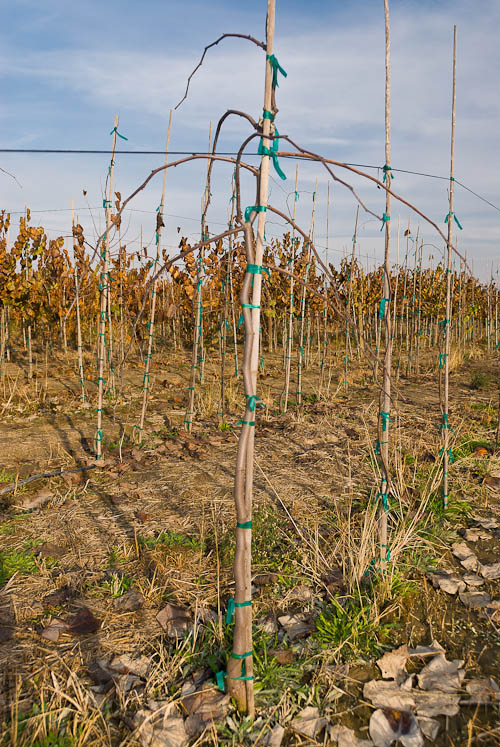
One of the debates is how tight to stake the tree? Do we want a straight trunk (well try to be semi-straight anyway) or be more creative and let the trunk have more waves in it? Since we cannot babysit this tree with constant attention - it gets a little of both.
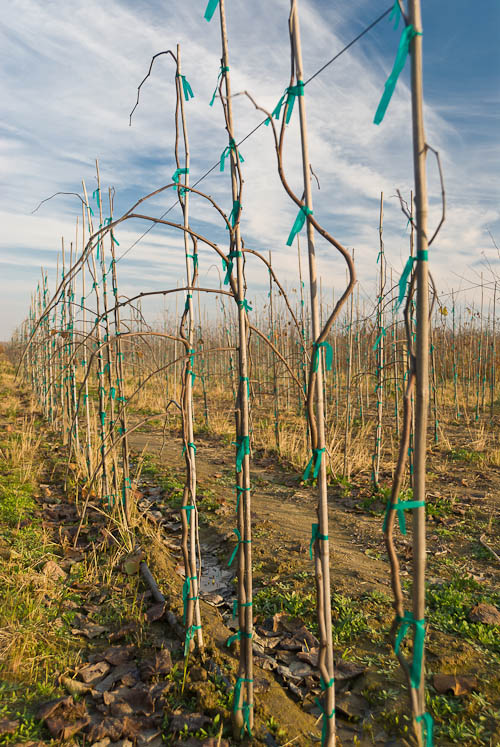
Regardless of how we stake it, the tree will develop in the landscape the weeping branches that reach the ground and hide the trunk. Our goal is to get it up to about 5 feet.
Ron Ludekens
Fall Colors
Every season has its attractions to a photographer, but fall usually is one of our favorites. The reds, golds and yellows displayed in nature attest to the creative side of God for our pleasure. Many of you live in absolutely stunning areas where fall color is rampant and even the travel industry thrives catering to the "leaf peepers".
And a lot of us live in a more subdued environment where we are tickled when we can plant a variety that gives us an additional season of enjoyment.
Here are a few of the items we grow that provides the color palette we like to enjoy:
Reds & Oranges
Chinese Pistache
My neighborhood has a lot of Chinese Pistache - both the seedling (with seeds) and the seedless Keith Davies. Here are some shots from last Saturday's walk around the block.
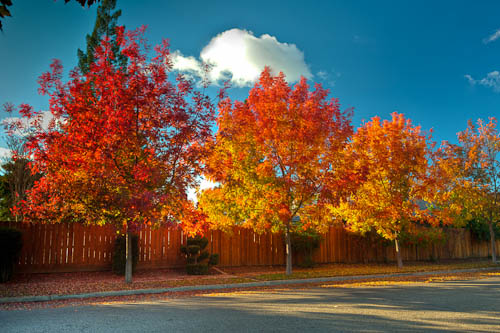
Seedling Chinese Pistache - Great Oranges and Reds - but colors will vary since each tree came from seed.
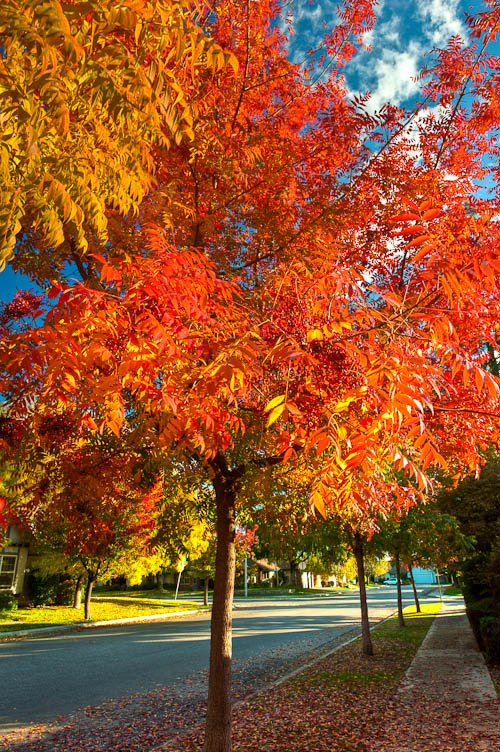
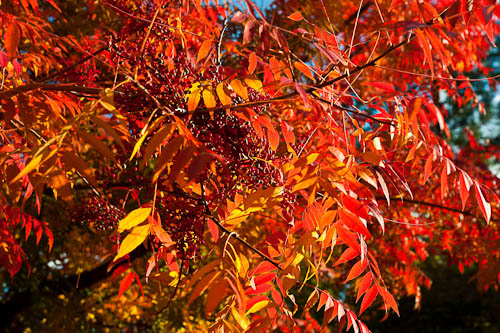
Look close and you can see the red seeds among the foliage. Pretty but slippery on the cement sidewalks which is why I like the Keith Davies.
Persimmons
Most people only think of the orange-red fruit of the persimmons which ripen in the fall and provide their own fall ornamental value along with good eating.
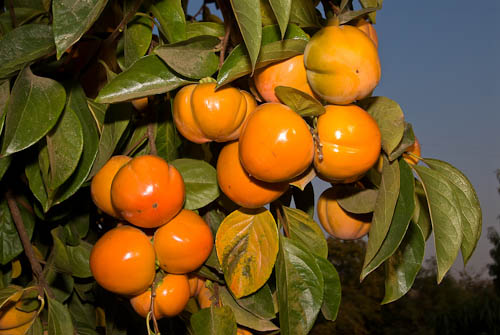
Many persimmons also have colorful fall foliage:
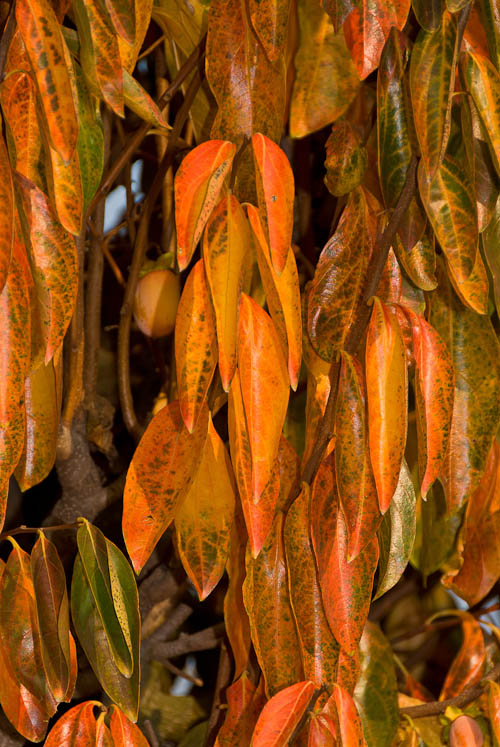
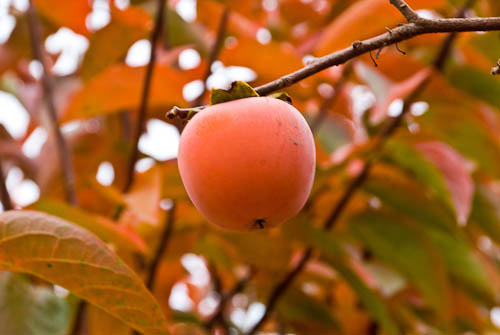
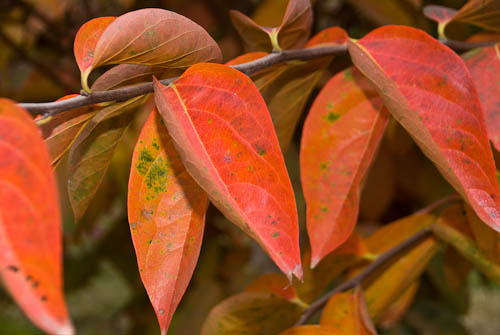
Forest Pansy Redbud
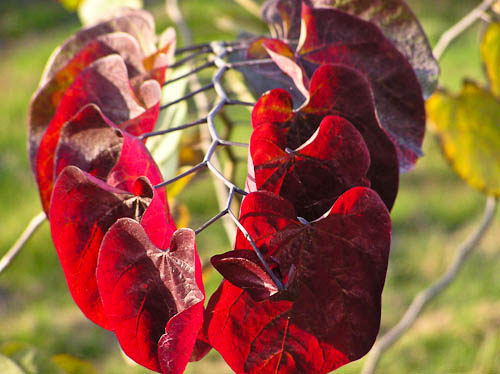
This November photo shows the new growth still vibrantly red. Older foliage is turning a non-spectacular yellow.
Trident Maple (Acer buergeranum) Our environment, like many of yours, is not conducive to successfully growing many of the great maples seen in the acidic soils of the east. I like the Trident Maple because it is a tough tree that handles our slightly alkaline soils and high summer temperatures. It provides good fall color as well.
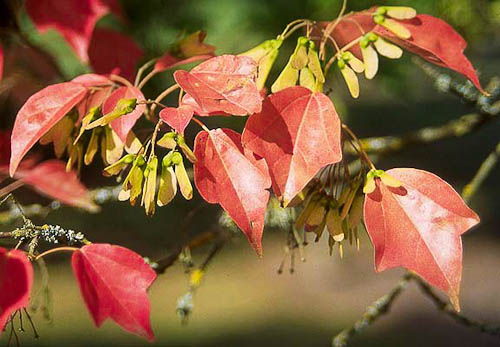
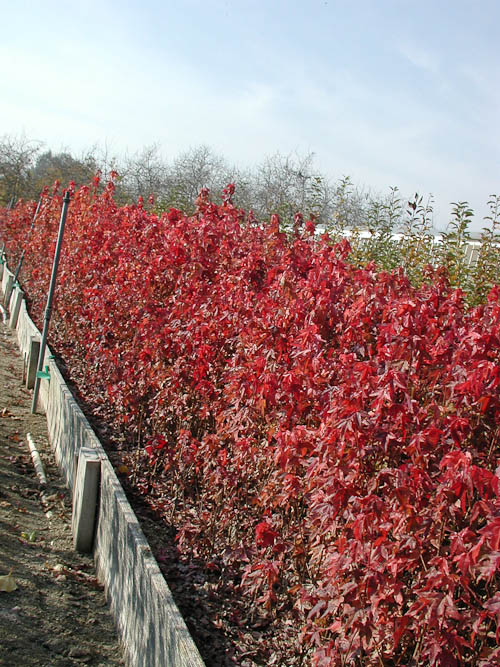
Seed bed full of Trident Maple (Acer buergeranum) seedlings showing red fall color.
Autumn Fantasy Maple
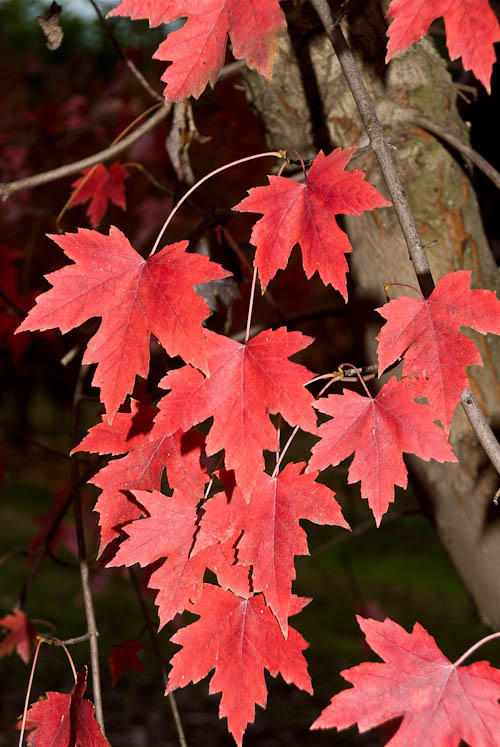
Golds & Yellows
European White Birch
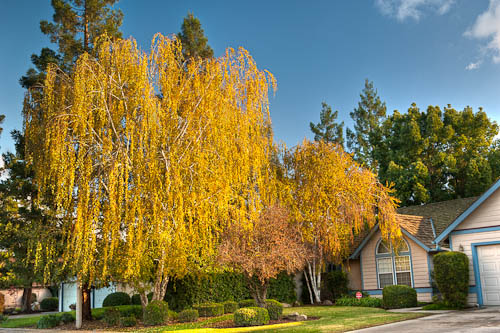
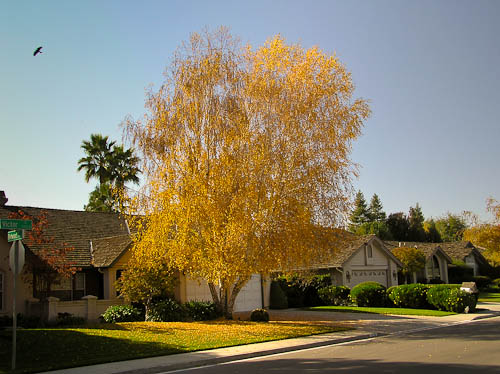
There are several plantings of Clump European White Birth (Betula pendula alba) in my neighborhood which provide attractive golden fall color.
Golden Desert Ash
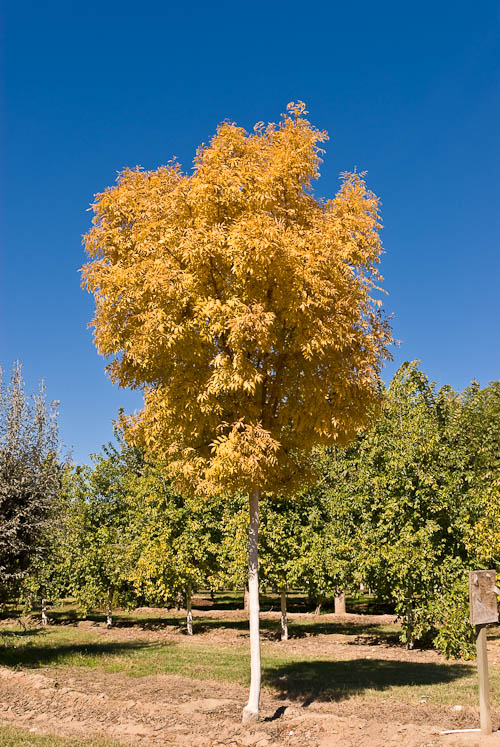
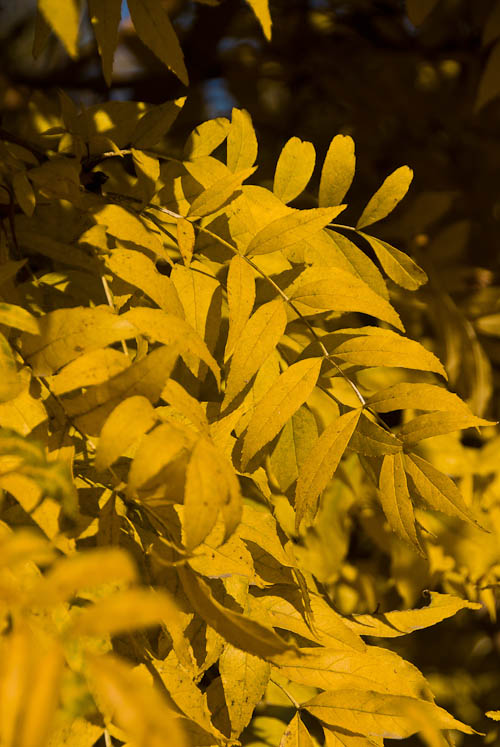
All summer long the Golden Desert Ash has a nice golden color which is especially showy against a green backdrop. In the fall, the golds turn even more golden.
Populus
Basically all the Populus family has attractive golden-yellow fall colors and there is not enough room to show them all here. I want to feature the Silver Leafed Poplars that have attractive green/silver summer foliage that turns into a stunning golden show in the fall.
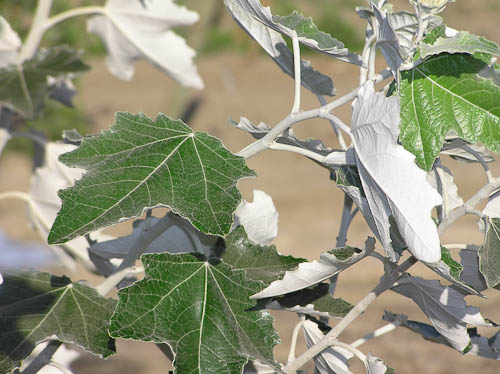
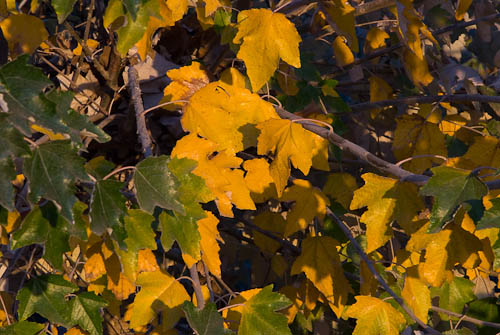
Autumn Purple Ash
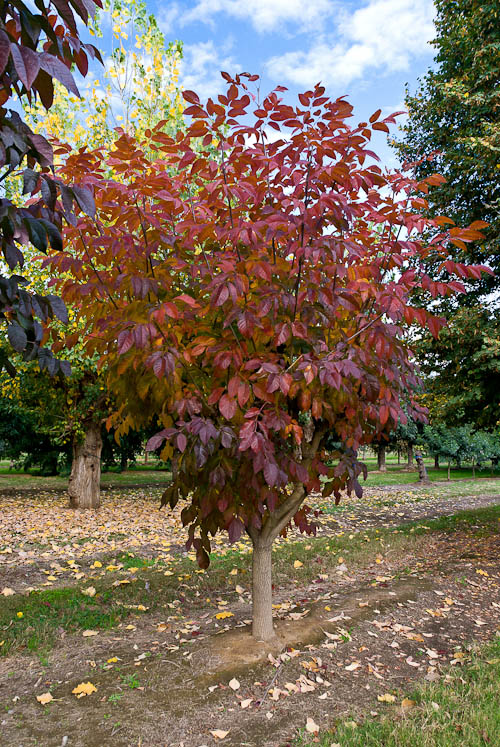
(Ignore the shape - this is a tree we butcher yearly to get budwood - use your imagination)
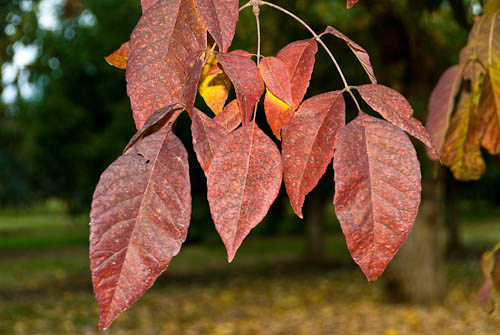
Autumn Purple Ash has attractive fall colors in the burgundy-purple ranges. This tree is an excellent shade tree in the summer and should have wider use.
And this was a brief photo walk around the block and a brief stop in the budwood orchard. What colors do you want to add to your landscape to enjoy for many years to come?
Ron Ludekens 11-20-2010
Ladyfinger vs Thompson Seedless Grapes
Question: Is there a variety of grape called Lady Fingers?
Is the Thompson Seedless often referred to as a lady finger?
Betty - Fresno, CA
Answer: Thank you for your question. Yes there is a grape called Ladyfinger. In fact, we have in our orchards two selections of Ladyfinger. For years we have been growing the Ladyfinger Calmeria selection and we are now half way through the process of converting our production over to the Ladyfinger Olivet Blanche selection which we feel is superior in taste, size and productivity based upon side by side comparisons in our orchards.
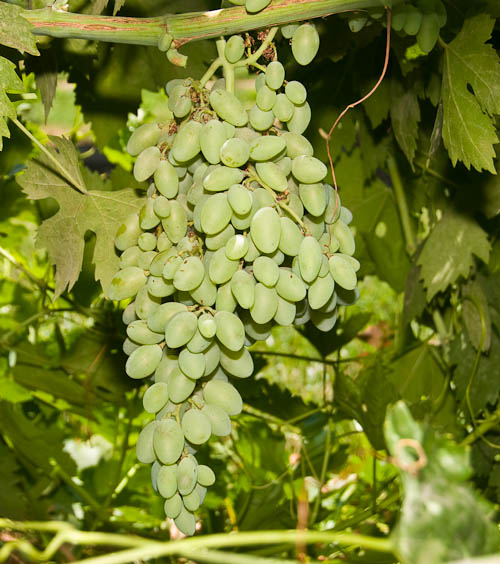
Ladyfinger Grape - Olivet Blanche selection (another month til harvest)
No, the Thompson Seedless Grape is not a Ladyfinger. The Ladyfinger grape is a green, seeded table grape, much larger than the Thompson Seedless - mostly because of the large seed inside. At one time the Ladyfinger grape was one of the most popular green grapes but ever since the Thompson Seedless Grape came along, the green seedless varieties have basically replaced Ladyfinger in demand and popularity. None the less, Ladyfinger is an excellent tasting grape - but with a seed.
Everyone knows the Thompson Seedless Grape because it was basically the first popular seedless grape and is the name that still pops first in consumer's minds making it our most popular seller for the homeowner market. Thompson Seedless Grapes is the California name for the white seedless grape variety 'Sultana' which likely originated in Persia or modern-day Iran. It was named after William Thompson who made it popular and was an early day grape grower near Yuba City, California. At one time it was unquestionably the most planted grape in California for fresh eating and drying into raisins but new plantings of green seedless grapes are being made with newer varieties that produce larger fruit at different times of the summer.
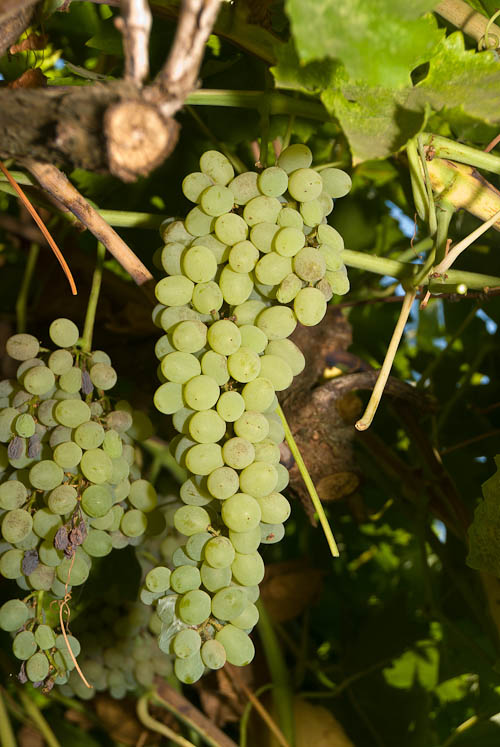
Thompson Seedless Grapes
Thompson Seedless was the parent grape for much of the breeding efforts that have produced many of the other seedless varieties we have all come to love.
Seedless Grapes All Summer Long
There are now a multitude of seedless grapes available and we grow a large number of them. Green/White, Red and Black/Purple selections. For many climates there are selections for early season, mid season and late season seedless grapes - something we try to offer our retail customers.
Here is an example of all summer long seedless grapes for your Central California climate:
Early Green Mid Season Green Late Season Green
Perlette or Delight Thompson or Princess Autumn Seedless
Early Season Red Mid Season Red Late Season Red
Flame Seedless Ruby or Canadice Crimson Seedless
Early Purple/Black Mid Season Purple/Black Late Season Purple/Black
Black Emerald Black Monukka or Summer Royal Autumn Royal
Ron Ludekens 11-5-2010
Do Rootstocks Affect Chill Hours?
Question: Do chill hours increase in dwarf fruit trees over what they are for the same variety in standard size tree? Maureen - Lakeland, Florida
Answer: Maureen, good question. To the best of my knowledge dwarfing rootstock or semi-dwarfing rootstocks do not change the chill requirements on the fruit trees. On the other hand, dwarfing and semi-dwarfing rootstocks often cause the tree to fruit earlier in its life (often called making it precocious) so I would not absolutely rule out minor changes.
I did an Internet search and have found no information on the subject.
We have seen high chill varieties put wrongly in low chill areas (example might be putting an Elberta Peach in Lakeland, FL.) and the top eventually dies since it will not leaf out and the rootstock will continue to thrive. In these instance the rootstock is not imparting it's characteristics to the budded top.
I wish I could say it did so changing a rootstock would allow more deciduous fruit trees to thrive in Lakeland Florida. You may have highly desirable weather, but it limits the fruit choices for the fruit trees requiring more chilling hours.
Ron Ludekens
Pruning Young Apple Tree
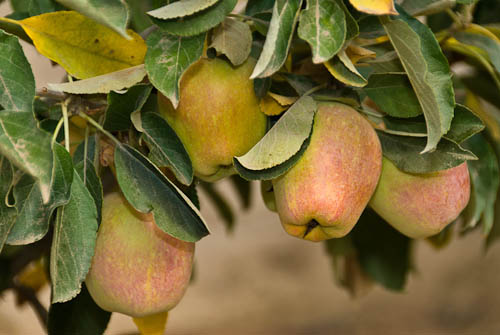
Anna Apples - Early July Photo - from L.E. Cooke Orchard
Question: I've never owned fruit trees and now have an Anna's Apple tree. It's late Oct. and I have a load of apples on my 5' tree. I have read that I need to prune but all of the sites I've been to on the net show tree pruning on tree's without leaves or apples. Should I prune off the apples and branches?
Help!!! Val -Westminster, CA
Answer: Congratulations on your first crop of apples. At least I am assuming it is your first crop since you mention the tree is only 5 feet tall and Anna is supposed to fruit in late June but new plantings frequently throw off timing from more established trees.
I like to remove fruit from young trees so the tree puts more energy into growing the roots and branch structure instead of growing fruit. And young tree fruit often is not as sweet and tasty as a more mature tree. I remove the fruit for up to three years - but most people find that they are too impatient and want their fruit now! Don't blame them since we plant fruit trees to get the better taste from tree ripened fruit. For your tree, this late season fruit plucking might not make much difference in growth except your tree still needs to store up starches and other food in the roots for the upcoming dormant season. Also picking the heavy fruit might prevent breaking of the young branches.
I would not prune the tree until it is dormant. Right now it needs its leaves to provide the food the roots store up for next spring's new growth. As the tree grows older you can consider light pruning during the growing season but save the heavy pruning for the dormant time.
When the tree is dormant, prune it for the shape and branching you want for the future. I like to prune my trees short with low branching so I don't need ladders when the fruit is ripe. Others like to keep it higher to mow under it (I don't like to plant fruit trees in lawns). Apples can be pruned in many ways - central leader, vase shapped, espaliered, etc. Here are some sites that give detailed information:
Netherlands Garden Writer with nice photos
I like this book for information on pruning:
Pruning Made Easy: A Gardener's Visual Guide to When and How to Prune Everything
I wish you great success and enjoyment of your future crops!
Ron Ludekens
Are Jujubes Self Fertile?
Question: 3years ago I bought a Sherwood jujube from Doan's Nursery in Irving, TX. It had tags from your farm. While it has grown well and flowered profusely in the last two years it has not made any fruit. I read somewhere that another variety planted close by might help. Is this true and if so what variety would you recommend? Thanks a bunch in advance. Ruven - Flower Mound, TX.
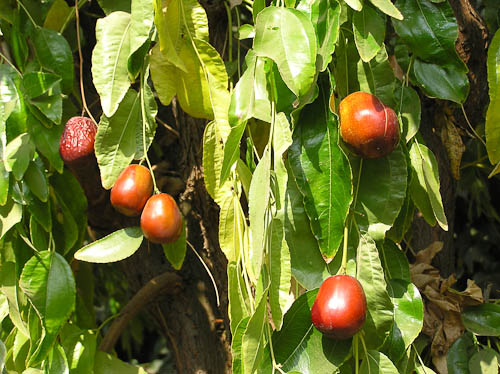
Sherwood Jujube
Answer: This is an interesting and troubling question. Generally, all of the nursery growers I know believe they are self fertile or at least semi-self fertile and have no reason to doubt them until a question or experience like yours pops up. Searches on Google seem to concur. But this is about the third time I have heard it on the Sherwood so makes me wonder too.
I called Roger Meyer from Valley Vista Kiwi in Fountain Valley,CA about your question. He is the one person I know who is a walking encyclopedia on Jujubes and grows many himself in his orchards. Of the Sherwood, he reminded me that it came from a single tree in Louisiana so it must have been at least semi-self fertile. He also noted that in his Southern California climate, it blooms very heavily in May but he never sees any fruit set until late July. I asked about method of pollination and he said he never sees bees but does see a lot of ants and other insects on the flowers. This observation coincides with a very good article by the California Rare Fruit Growers here: CRFG - Jujubes. The method of pollination seems to be by wind and insects (ants) but not bees. (Any chance you have great insect control and thus have eliminated the mode of pollen transport?) What I found interesting was the statement that each flower was receptive to pollen for only about a day. Thankfully it blooms for a fairly long time.
Here is what I know from personal observation. We have 19 Sherwood Jujube trees which we use for our cutting wood in row 1 of our scion wood orchard. Used to have 20 trees but one was removed because we never saw fruit on it (we never cut from trees that have not had the fruit verified as true to name). So it is possible that a single bud that started that tree misbehaved in its genetics - bud sports do occur naturally in nature. Rows 4 and 5 have Jujube seed trees and rows 5, 6 and 7 have some Lang and a lot of Li Jujube trees. About 10 acres away in row 34 we have the GA866. And these GA866 fruit well with nothing else around them except for like variety trees.
Of this group, the Sherwood produces the least fruit - a little stingy compared to the others in my opinion. But then the others fruit their crazy heads off so it is a relative thing. Sherwood was also my favorite (sweeter and less thorny) until the Sugar Cane came along which really tickles my sweet loving taste buds. Obviously most these bud wood orchard Jujube trees are close enough to the others for some cross pollination by insects and the prevailing northwest wind is normally from the side of the other varieties. So I do not have any trees isolated at this time to use as a check. (Add to the project list...)
I always recommend pollinizers be planted for commercial orchards since fruit set is usually heavier. This is not normally needed for most (not all) fruit trees we sell for the home gardener. They usually get more fruit that a family needs all on their own. You might try planting another variety to see if it solves the problem. Please let me know the results.
One last thought - again a little lack of experience on my part for your climate and location. The Sherwood ripening is about a month later than the other Jujubes putting it into mid to late October in our climate. With this year's cooler spring, everything is even a little later. I know your warm season starts later than ours and ends earlier so I suspect you are on the edge of seeing consistently successful Sherwood crops. This is unrelated to the fact that you have no fruit at all, but it does raise the question whether it will fully ripen each year when you do. If any reader has personal experience with Sherwood in similar climate latitudes, I would welcome your feedback and learn from it.
Roger was hoping to go to an international Jujube symposium next year if it gets fully organized. He said he would ask the group what they have experienced and add that to our collective knowledge.
You asked what to plant as a pollinizer. All the Jujubes in our orchard overlap in bloom so any should suffice. The Li is still the most popular due to size of fruit and heavy production so you might like that one as a "sure bet" for it's own production.
Ron Ludekens
September 27, 2010
Protecting Figs in Cold Country
Question: How do i care for a black mission fig tree in the winter i live in long island new york and what is the best location to plant this tree also can i plant this tree now. John
Answer: I am amazed at the number of figs that we ship into Long Island as well as New York, New Jersey and other areas where figs really should not be grown. That's right - the climate is normally too cold for the semi-tropical fig tree. But I have seen the absolute passion people in these areas have about figs - many with roots back to Italy or the Mediterranean regions where the fig tree thrives.
This passion for the fig has made a lot of people very creative in making forms of protection to help the fig through the coldest months.
Figs do not like temperatures below freezing for an extended period because the sap never goes to the roots like most deciduous trees do. Figs never really harden off and the sap and other fluids in the branches will freeze and damage cell linings and tissues when it freezes. It all depends upon how cold and how long it stayed cold. We try to harvest all figs from our fields before night time temperatures get below 32 degrees. Usually a brief dip under freezing doesn't hurt, but once I start seeing it drop to 28 degrees F or lower, it is usually cold enough for a long enough period to cause damage. Of course smaller branches freeze easier than larger ones. Thus the trunk, being the largest is the last to be damaged. Minor damage to branches can be cut off (should be cut off). See this page on how to tell if a fig has frost damage: Fig Frost Damage
Some things to consider:
- Cold wind can dry out and cause additional damage. Can the fig be planted in a wind protected area?
- Cold air falls to the lowest area. Plant on a hillside instead of the bottom of a valley.
- Take advantage of the winter sun and plant on the south (or south west) side of a home so the tree is not hidden from the sun by shade.
- Plant next to the heated home where radiated heat might be available (newer, properly insulated homes should not offer much help) but leaky older homes help the fig but hurt your pocket book. I have seen figs growing on Long Island right at the base of the building against the wall and under the eaves. This gives an advantage when wrapping the outside of the tree and capturing heat from the building. See photo example:
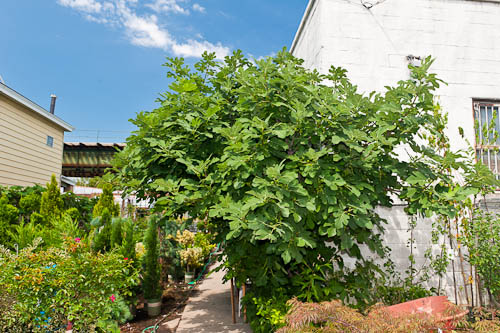
Old Brown Turkey Fig - Priority Landscaping - Brooklyn, NY
It has been here many years - frozen back occasionally based upon number of trunks coming from the ground.
- Create a way to wrap the tree so it captures ground heat. I have heard (not seen) of people putting Christmas Lights on the tree inside the wrap for the coldest nights. Be very careful about fire and electrical danger!!!
- And many people put the fig into large (very large) pots with wheels under them to roll the whole tree into a garage or shed where it can be protected from the winter freeze.
Here is what others have said: Growing Figs in Brooklyn? and Garden Web Forum?
I am sure there are other ideas out there. I would love replies from those of you readers who do any of this protection and photos if possible.
As long as the roots are not damaged and any dead limbs are cut off the tops, a fig should re-sprout from its roots (look more like a bush - not a tree). Whether it has a long enough season to grow back and have fruit reach full ripeness will depend upon your weather that season.
Be careful that you don't make the tree so comfy warm that it decides to wake up and start leafing prematurely.
Hope this provides a little guidance.
Ron Ludekens
Weeping Double Red Flowering Peach - Edible Fruit?
Thanks, Julie - Prattville, Alabama
Answer: Most fruit trees (but not all) that are known for their beautiful spring blooms produce fruit. For the most part they are not very enjoyable to eat - at least not to our discriminating taste buds. That is the case with the Weeping Double Red Flowering Peach. I consider it a nuisance fruit - a negative more than offset by the spring bloom. So putting in another tree for pollination would not make it any better. Be thankful they drop when they are smaller an easier (less squishy) to clean up.
Two flowering peach trees that I really like are the Red Baron Peach and the Saturn Peach. Both have stunning 2-3 week spring blooms and excellent tasting summer fruit.
Ron L.
How Much Sun for Wisteria?
